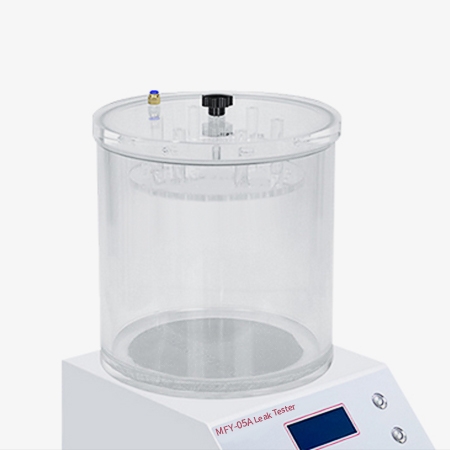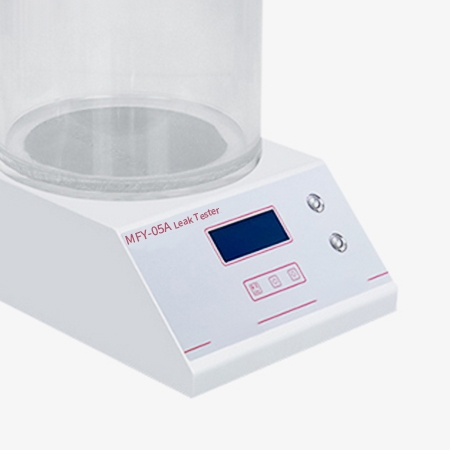The vacuum leak tester for packaging has a vacuum holding time of 0~60 minutes, power supply of 220V 50Hz. Come with a transparent and sturdy glass vacuum chamber and independent operation buttons. The vacuum leak testing machine is applied in the food, cosmetics, and pharmaceutical industries for sealing packaging to protect the quality and safety of the products inside.

Transparent vacuum chamber, visualization of the detection method
- The transparent vacuum chamber of the vacuum leak detector is an important part. It is usually made of special transparent materials to form a closed test environment.
- The transparent vacuum chamber makes the leak detection in vacuum system process visual, and allows direct observation of the leakage of the sample. Therefore, the package leak tester is widely used in various scenarios that require sealing tests, such as flexible packaging products, cosmetic packaging, electronic semiconductor packaging products, medical devices, etc.

Accurate LCD display, high degree of automation
- The vacuum detector can realize functions such as microcomputer control, LCD display, digital preset test vacuum degree, and vacuum holding time, which improves the accuracy and efficiency of the test.
- The vacuum system leak detection can automatically replenish air at constant pressure, automatically end the test, and automatically backflush and unload. The vacuum leak tester can preset test parameters, is equipped with high-quality accessories, and accurately detects and solves potential leakage.
Application
Package seal testers ensure that the sealing performance of product packaging meets standards and requirements. In the food industry, seal testers are used to test the sealing performance of food packaging to avoid external contamination and oxidation. The sealing performance of pharmaceutical packaging is crucial to maintaining the quality and safety of drugs, and seal testers can be used to test the sealing performance of pharmaceutical packaging. Cosmetic packaging needs to be protected from oxidation and external contamination to maintain product quality and stability.

Food

Injections

Cosmetics

Tablets
| Model | SISCO-VLD-MFY-05A |
| Vacuum Degree | 0--90Kpa |
| Vacuum Accuracy | Level 1 |
| Air Source Pressure | 0.5Mpa~0.7Mpa |
| Vacuum Holding Time | 0-60min |
| Host Size | 500 X 400 X 300 (mm) |
| Host Weight | 15kg |
| Operating Temperature | 15°C-50°C |
| Sealing Chamber Size | 400 x 400 x 500 (mm) |
| Sealing Chamber Weight | 15kg |
| Relative Humidity | ≤80%, no condensation |
| Power Supply | 220V 50Hz |
Q1: What is the vacuum leak tester for packaging?
A1: A vacuum leak tester for packaging is a device used to detect leaks in sealed packaging by applying a vacuum and observing the package's response. It is commonly used in industries such as food, pharmaceutical, and consumer goods to ensure package integrity, prevent contamination, and maintain shelf life.
Q2: How does the vacuum leak tester for packaging work?
A2: The leak tester uses the negative pressure method principle to evacuate the vacuum chamber, causing a pressure difference between the inside and outside of the sample immersed in water, and observing the gas escape to judge the sealing performance of the sample.
Q3: What does the vacuum leak tester for packaging do?
A3: A vacuum leak tester for packaging is used to check whether a sealed package has any leaks by creating a vacuum around it and observing how it reacts. Its main function is to ensure the packaging is airtight and secure, which is critical for protecting the contents from air, moisture, bacteria, or other contaminants.
Tips: How to use a vacuum leak tester for packaging?
Check the equipment, prepare the sample, and seal it according to the test requirements. Inject an appropriate amount of water into the vacuum chamber, adjust the liquid level automatically, turn on the power switch, and set the test parameters. Place the sample in the chamber, ensuring the distance between the top of the sample and the water surface is at least a certain height (e.g., 25mm). Then, seal the vacuum chamber. Start the test. At this time, the air in the vacuum chamber is pumped out, and the leakage is reduced. End the test, and then turn off the vacuum pump and the power switch.
Thank you for buying industrial test and measurement equipment on SISCO.com, all products sold by SISCO and the partner cover a 12 months warranty, effective from the date of receiving the products.
What is covered?
SISCO is responsible for providing free spare parts, and free technical support to assist the customer to repair the defective products until the problem is solved.
What is not covered?
- Product purchased from anyone other than a SISCO store or a SISCO authorized reseller.
- Expendable parts.
- Routine cleaning or normal cosmetic and mechanical wear.
- Damage from misuse, abuse or neglect.
- Damage from use of parts other than SISCO approved.
- Damage from use outside the product’s usage or storage parameters.
- Damage from use of parts not sold by SISCO.
- Damage from modification or incorporation into other products.
- Damage from repair or replacement of warranted parts by a service provider other than a SISCO authorized service provider.
- Damage caused by the application environment not meeting the product usage requirements and the failure to perform preventive maintenance.

